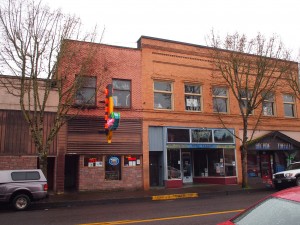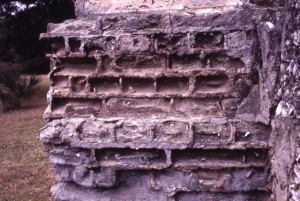Historic masonry matters. In Oregon, it speaks of solid buildings constructed with local materials and labor; it expresses a community’s values, joie de vivre and aspirations. The investment in fine masonry made by owners and other business people in many of Oregon’s cities and towns stand today as reminders of how important buildings were—and still are—in handing down stories of our past. Back then, people thought about the future and made sure that what they did and what they made—and built—would stand the tests of time.

(Photo courtesy of Lauren Allsopp)
Historic masonry similarly deserves proper conservation today. The University of Oregon’s Historic Preservation Program takes a keen interest in preserving the built environments that speak volumes about our heritage. With this in mind, University of Oregon graduate and undergraduate students, taking Adjunct Professor Lauren Allsopp’s class “Building Pathology – Masonry,” spent 12 weeks analyzing masonry structures of all kinds in Cottage Grove and writing recommendations for building owners in the city. Cottage Grove’s Main Street is a classic example of a late Victorian town with both a mining and an agricultural heritage. The work culminated in the Masonry Conservation Handbook, copies of which were sent to the Mayor and City Offices of Cottage Grove, the State Historic Preservation Office and Restore Oregon. The complete report is available online.
For the class, “masonry” was defined as adhered veneers, stone, terra cotta, concrete, cast block and brick. The history and characteristics of each material were covered, then problems and causes were addressed, and finally, recommendations were given. The project was designed to help owners of masonry structures as well as interested community members. There’s a saying in the historic preservation field that “good bones make for long lives.” Masonry structures that were built well over a century ago are capable of lasting another century and beyond with proper care and attention.

one of the more common masonry repair errors
(Photo courtesdy of Lauren Allsopp)
Most TV programs about restoring old buildings give the impression that to maintain, repair or restore a masonry building means a trip to the local hardware store to pick up some bags of Portland cement or a caulking gun. As can be seen in the picture of a “cement repaired” brick wall, in the world of masonry restoration nothing could be more damaging to masonry. Research has shown that such applications are capable of seriously degrading fine old structures that otherwise would have had decades, if not hundreds, more years left in them. The Masonry Conservation Handbook is intended to help with these decisions.
While the masonry study focused on Cottage Grove, the Handbook has value to anyone owning a masonry building in Oregon.

